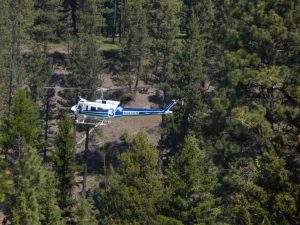
Helicopters suppressing wildfires
As spring rolls into summer state and federal land managers are bracing for the inevitable wildfires to start. The big question is what type of fire season will the West Coast have in 2016.
In Washington State, there have been three so far of note. Two, oddly enough, in Western Washington of unannounced origin and a third, in Yakima County, east of the Cascades, which is alleged to have been started by the careless use if fireworks. That investigation at this writing remains ongoing. The total acreage of these wildfires is a bit less than 700.
2016 Wildfire Season?
The National Interagency Fire Center, located in Boise, Idaho is predicting a reasonably normal fire season for the country as a whole in its May Advisory.
Some notable exceptions are in the western part of the country. Alaska and Hawaii have a great risk of wildfires throughout the season. Additionally, the higher predictions beginning in Arizona and California, moving northwards as the season advances. The Pacific Northwest is at a mixed level of danger due to a reasonable snowpack, albeit one that is melting rapidly, and higher than normal moisture to date. Southern California remains in a drought cycle which adds to the dangers regionally.
As temperatures rise and flora and trees dry the dangers will be further enhanced. Weather and closure awareness is key to avoiding the fire hazards along with being careful with fire, motor vehicle operation and general safe camping and hiking practices. In Washington State, the Department of Natural Resources has been conducting intensive helicopter crew training for fire spotting and attack. This is very serious business as helicopter operations are inherently hazardous without the low level operation in rapidly shifting wind conditions along a fire front. It’s noisy, but it’s time, effort and money well spent.
Climate change is an often cited contributing factor to fires
Certainly the hotter seasons tend to have more wildfires. Some research is being conducted on the effects of fires prior to the arrival of non indigenous people to the west. Preliminary results, over a short period of time appear to show more fires prior to this time. The study area is quite limited and it is by no means applicable as a general result.
One certain factor is that the unintended consequence of the 1940’s through 1990’s of fighting every wildfire in every locale, with the goal of total suppression. The effect has, in may places, to allow much more brush and debris to form as an under-story. This chokes the forest making passage for wildlife difficult as well as providing ready fuel for a small fire to grow into a conflagration.
Additionally, human intrusion into wild lands through either permanent or temporary residences bring on the requirement for battling fires to preserve structures and lives. The esthetic desire to halt fires plays a large factor as well. People, quite frankly, like to see stands of trees. In some cases the trees are actually invasive which may not be native to a particular region. For example Douglas Firs intruding into Ponderosa Pine forests or the scrub steppe of Eastern Washington.
While both trees have remarkable abilities to withstand fires if the under-story is allowed to grow unimpeded then fire may gain access to the higher branches of the trees spreading through Crown Fires.
A careful and rational use of prescribed burns is very useful in removing this under-story as well as clearing the forests for wildlife habitat. Objections are often raised to these burns on esthetic grounds as well as the air pollution which results from smoke. This dichotomy may never be fully resolved small number of controlled fires, carefully managed, are much better than huge fires raging across thousands of acres.
In all events it’s a balancing act to maintain life and property as opposed to allowing wildfires to burn. Fire is a part and parcel of the natural world. The effects of waging war to extinguish fires will last at least as long as those wars were waged. Fire restores and nourishes the forests and brush lands across the west and needs acceptance and guidance to allow the healthy renewal of our natural world.
Article written by: Robert Morthorst